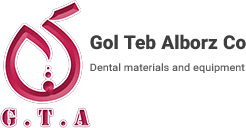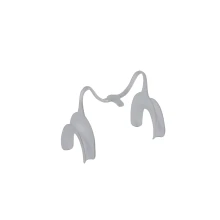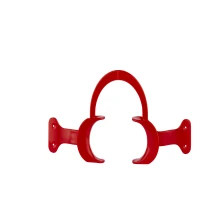-
Orthodontic and Dental Retractors :
Retractors in Dentistry
In general, retractors are instruments designed to provide an optimal and dry working field, enhance visibility and access, and protect soft tissues during dental procedures.
1. Cheek & Lip Retractors
Clinical Applications:
-
Orthodontics (bracket bonding, bonding, and debonding).
-
In-office whitening.
-
Clinical photography (documentation and treatment planning).
Features: Transparent design (for adequate light transmission), available as sterilizable or disposable types.
2. Tongue Retractors / Depressors
Applications:
-
Endodontics (especially in posterior molars for tongue control).
-
Apicoectomy.
-
Implant placement in posterior regions.
Features: Usually made of metal or stainless steel, autoclavable, anatomically designed to minimize tongue pressure.
3. Dry Field Systems (e.g., Nola Retractor)
Applications:
-
Provides a completely dry field for composite restorations, sealants, and orthodontic procedures.
-
Can be used as an alternative to rubber dam in some cases.
Advantages:
-
Simultaneous isolation of lips, cheeks, and tongue.
-
Continuous saliva suction.
Note: Offers greater clinical efficiency than simple cheek retractors, particularly for long procedures requiring extensive isolation.
4. Surgical Retractors
Applications:
-
Oral and maxillofacial surgery (third molar surgery, flap reflection).
-
Bone grafting, implant placement, apicoectomy.
Features:
-
Made of metal, autoclavable.
-
Available in diverse designs (Minnesota, Langenbeck, Austin) for specific surgical needs.
Advantages: Some models also reflect light, thereby enhancing the surgeon’s visibility in addition to tissue retraction.
📌 Summary for Dentists
Retractors are essential tools for isolation and exposure:
-
In orthodontics and whitening → Cheek/Lip Retractors.
-
In endodontics and minor surgeries → Tongue Retractors.
-
In restorative and long orthodontic procedures → Dry Field Systems (as an alternative or complement to rubber dam).
-
In oral and periodontal surgeries → Surgical Retractors.
Types of Dental Retractors
1. Dental Oral Dry Field System (Nola Retractor)
A complete system (not just a simple retractor).
Components:
-
Lip and cheek retractor → retracts lips and cheeks.
-
Tongue holder → keeps the tongue away from the working area.
-
Saliva suction system → continuously removes saliva and maintains a dry field.
Applications:
-
Orthodontics (dry field is essential for bracket bonding).
-
Whitening → improves effectiveness of bleaching agents.
-
Restorative dentistry (e.g., composite restorations).
Major Advantage: eliminates the need for an additional assistant for continuous saliva suction.
2. Orthodontic / Whitening Cheek Retractor
A cheek retractor commonly used in orthodontics or whitening procedures.
Features:
-
Made of clear plastic or silicone.
-
Provides full visibility of the dentition.
Applications:
-
Improves access and visibility during bracket bonding.
-
Protects lips and cheeks from bleaching agents during whitening.
Available Designs: C-shaped, O-shaped, or double-sided (retracts both lips and cheeks simultaneously).
3. Autoclavable Dental Mouth Opener
A device to maintain the mouth open during dental procedures.
Features:
-
Made of polycarbonate or durable silicone.
-
Autoclavable → can be sterilized and reused multiple times.
Applications:
-
Oral surgery, endodontic treatments, orthodontics, and prosthodontics.
-
Particularly useful for patients who cannot keep their mouth open for extended periods.
4. Disposable Dental Lip & Cheek Retractor
A lightweight, single-use retractor.
Features:
-
More economical and designed for one-time use.
Applications:
-
Impressions.
-
Fabrication of mouthguards or bleaching trays.
-
Short and simple procedures.
Sizes Available: S, M, L → Size L is typically used for adults.
-







